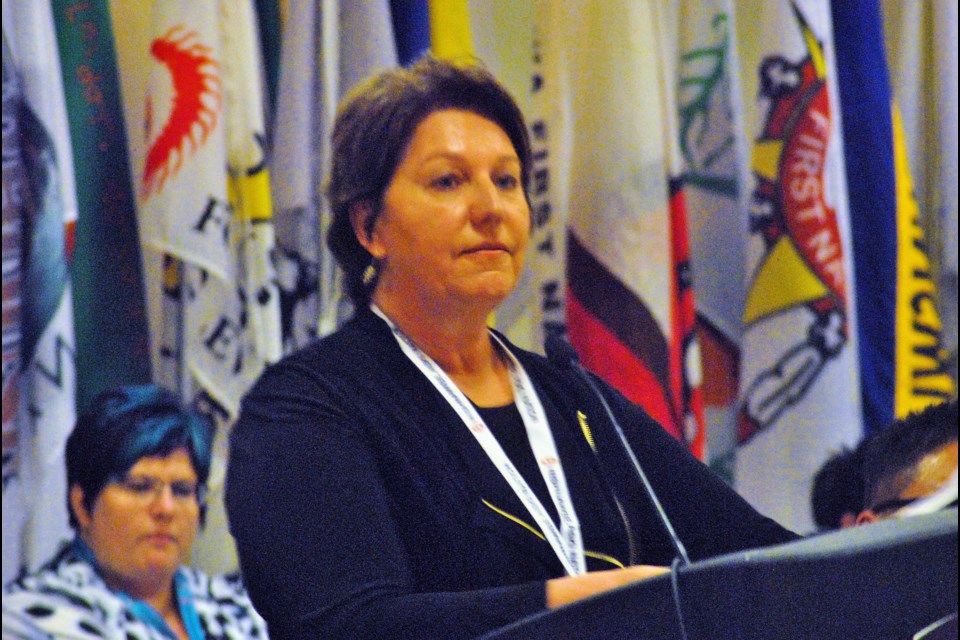The Far North Electoral Boundaries Commission (FNEBC) has been formed by the Ontario government to help create one, possibly two new ridings, to better represent the primarily indigenous communities north of Kenora and north of Timmins.
Joyce Pelletier, a lawyer and judge from Thunder Bay, was named to be the chair of the commission.
“The commission will organize and attend community meetings in those two electoral districts, to hear from the communities with respect to adding one or maybe two new ridings in those two geographic areas,” said Pelletier.
Pelletier was interviewed yesterday on CBC Morning North about the work of the Far North Electoral Commission.
The Ministry of the Attorney General announced the Commission members on May 8, 2017, and two days later Chair Joyce Pelletier, members Theresa Hall, and Eric Fisher travelled to Timmins to present the mandate of the commission to the annual NAN Spring Chiefs meeting at the Senator Hotel in Timmins.
The FNEBC’s mandate is to make recommendations on the creation of maybe two additional ridings in the Kenora Rainy River and Timmins James Bay electoral districts,” explained Pelletier.
The work of the Commission will result in increasing the number of ridings in northern Ontario from the current 11 to either 12 or 13.
Members of the commission, in addition to its chair, Joyce Pelletier include:
- Greg Essensa, Ontario's chief electoral officer since 2008. Previously, he served as the director of elections and registry services for the City of Toronto.
- Michael Pal is an assistant professor in the Faculty of Common Law at the University of Ottawa, specializing in election law and constitutional law.
- Theresa Hall is a former justice of the peace, the first Cree woman to hold the position. Hall, a former Chief of Attawapiskat First Nation, is a survivor of the Indian Residential Schools of St. Ann, Fort Albany and Fort George, Quebec.
- Hall has a BA in Native Studies from Laurentian University and currently works as a freelance Cree interpreter and teaches Cree language courses at Laurentian University.
- Eric Fisher served 20 years as Chief and council member for Wabaseemoong (Whitedog) Independent Nations. He is currently the leadership engagement lead at Indigenous and Community Engagement, a consulting firm that focuses on Indigenous community engagement, stakeholder relations, capacity development, and community development. He is fluent in the Ojibway language.
“The Commission itself holds no position on the need or the lack of a need to establish two ridings in Ontario’s Far North,” Pelletier said. “Our responsibility is to listen to the members of the community, report back to the Ontario government on what their thoughts are on representation, and boundaries for the new proposed new ridings.”
The Commissions work is based on the criteria established by Representation Act, 2015 as amended by the Election Statute Law Amendment Act, 2016 and they must:
- Identify communities of interest
- Ensure the new ridings increase representation of Indigenous people
- In proposing the creation of new ridings, consider existing municipal and other administrative boundaries
- Consider the sparsity or density and the rate of population growth in the area
- Identify the geographical features
- Note the availability of means of communications and transportation in the geographic area
- And representation of members of the legislative assembly from Northern Ontario
“The Ontario government has said it wants to create ridings to give better representation to Indigenous people in northern Ontario leading to the election of the first First Nations MPP for Ontario,” noted Pelletier.
The Report of the Far North Electoral Boundary Commission is due for submission on Aug. 1, 2017.
The Commission has three months to complete its fact-finding visits and public consultations with communities in some of Ontario’s most remote communities.
Once it is submitted to the Attorney General, the commission’s report will be made public and the government will introduce legislation to implement the commission’s final recommendation.
The changes must be in place a year from the date of the next provincial election in October 2018.
For more information, visit Elections Ontario.



